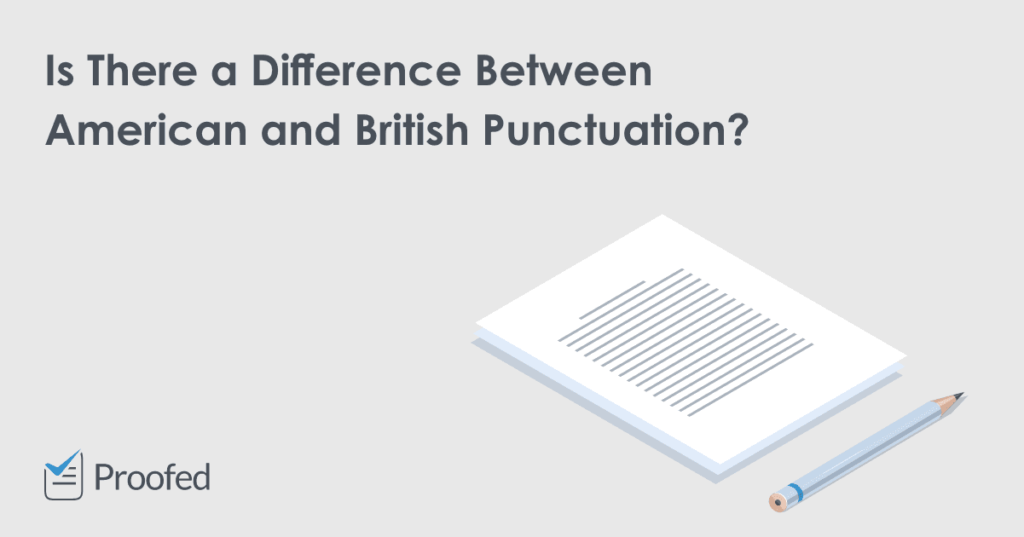Most people are aware of the spelling and grammar differences between American and British English. But did you know that there are punctuation differences, too? For example, three differences between American and British punctuation that you may want to keep in mind include:
- How we use quote marks and punctuation surrounding quote marks.
- Use of the serial comma (or Oxford comma, as it is known in the UK).
- How we punctuate abbreviated titles like “Mr.” and “Mrs.”
We’ll now look at how these work on either side of the Atlantic Ocean.
1. Quote Marks
The biggest difference between American and British punctuation is related to quotations.
This covers two distinct issues:
- Whether to favor “double” or ‘single’ quotation marks.
- Whether to place punctuation inside or outside of quotation marks.
In American English, we typically use double quote marks for the main quote. We would then use single quote marks for a quote within a quote. But this is the other way around in British English:
American English: Smith (2001, p. 34) writes that that witnesses “heard someone shout ‘Duck!’ loudly” before the explosion.
British English: Smith (2001, p. 34) writes that witnesses ‘heard someone shout “Duck!” loudly’ before the explosion.
In addition, American punctuation rules require all commas and periods to be given within quote marks. British English, meanwhile, only places punctuation within quote marks if it is part of the original text:
American English: Smith (2001, p.35) also reports that witnesses “suffered headaches,” as well as experiencing “feelings of nausea.”
British English: Smith (2001, p.35) also reports that witnesses ‘suffered headaches’, as well as experiencing ‘feelings of nausea’.
Here, for instance, we see that the British English version places the comma and period outside of the quote marks, which tells they were not originally part of the text being quoted.
2. The Serial/Oxford Comma
The serial comma (also known as the “Oxford comma” in the UK) is a comma placed before the last item in a list of three or more things. Most American English style guides recommend using this comma as standard:
I believe in good spelling, grammar, and punctuation.
Many British style guides, however, recommend omitting the final comma:
I believe in good spelling, grammar and punctuation.
The exception is that both American and British English use a serial comma to ensure clarity. For example, the following sentence is ambiguous:
Find this useful?
Subscribe to our newsletter and get writing tips from our editors straight to your inbox.
I’m going out with my brothers, Tim and Dave.
Is it a list of three items? Or are my brothers named Tim and Dave? We can clarify this instantly by adding a serial comma before “Dave,” as shown below:
I’m going out with my brothers, Tim, and Dave.
Here, we can easily see that “my brothers,” “Tim,” and “Dave” are all separate people. As a rule, then, we can summarize serial comma usage as follows:
- In American English, the serial comma is often used in lists as standard.
- In British English, a serial comma is only required when a list would be unclear without one, such as in the example above.
You will find exceptions to this rule, as some people have strong feelings about the serial comma. However, it remains a good general guideline to follow if you’re unsure when to use one in your own writing.
3. Periods After Titles
Finally, we have the use of periods (or “full stops”) after abbreviated titles.
The difference here is that American English places a period after all titles (e.g., “Dr.” or “Mrs.”), whereas British English does not do this when the full term ends with the same letter as the shortened version (e.g., “Dr” or “Mrs”):
American English: Mr. and Mrs. Douglas walked home.
British English: Mr and Mrs Douglas walked home.
In British English, you only need a period when a shortened title does not end with the last letter of the full term (e.g., when “Professor” becomes “Prof.”):
American English: Dr. Douglas wrote a letter to Prof. Edwards.
British English: Dr Douglas wrote a letter to Prof. Edwards.
Consistency Is King!
The rules above cover punctuation conventions in American and British English. These are, however, quite flexible. If you don’t want to use a serial comma in all your lists, that’s your choice! You might upset a few patriotic pedants, but it is not strictly wrong to do this in American English.
You do, however, need to be consistent. For example, if you use double quote marks for the first quote in an essay, make sure to use the same style throughout. This will help to ensure two things:
- Your writing looks professional and demonstrates attention to detail.
- Your reader will know exactly how punctuation is being used.
This applies to both American and British punctuation. And if you’d like help checking the punctuation in your written work, just let us know.





